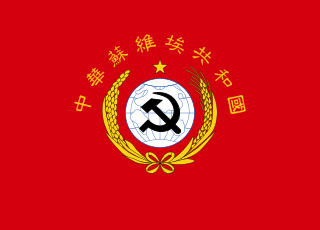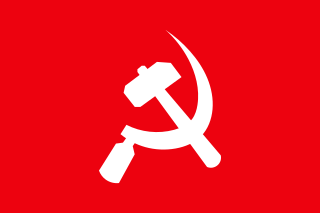Related Research Articles

The State Flag of the Union of Soviet Socialist Republics, or simply the Soviet flag, was a red banner with two communist symbols displayed in the canton: a gold hammer and sickle topped off by a gold five-point star. The flag's design and symbolism are derived from several sources, but emerged during the Russian Revolution. It has also come to serve as the standard symbol representing communism as a whole, recognized as such in international circles, even after the dissolution of the Soviet Union in 1991.

The hammer and sickle is a communist symbol representing proletarian solidarity between agricultural and industrial workers. It was first adopted during the Russian Revolution at the end of World War I, the hammer representing workers and the sickle representing the peasants.

The Chinese Soviet Republic (CSR) was a state within China, proclaimed on 7 November 1931 by Chinese Communist Party (CCP) leaders Mao Zedong and Zhu De in the early stages of the Chinese Civil War. The discontiguous territories of the CSR included 18 provinces and 4 counties under the communists' control. The CSR's government was located in its largest component territory, the Jiangxi–Fujian Soviet. Due to the importance of the Jiangxi–Fujian Soviet in the CSR's early history, the name "Jiangxi Soviet" is sometimes used to refer to the CSR as a whole. Other component territories of the CSR included the Northeastern Jiangxi, Hunan-Jiangxi, Hunan-Hubei-Jiangxi, Hunan-Western Hubei, Hunan-Hubei-Sichuan-Guizhou, Shaanxi-Gansu, Sichuan-Shanxi, Hubei-Henan-Anhui and Haifeng-Lufeng Soviets.
People's war, also called protracted people's war, is a Maoist military strategy. First developed by the Chinese communist revolutionary leader Mao Zedong (1893–1976), the basic concept behind people's war is to maintain the support of the population and draw the enemy deep into the countryside where the population will bleed them dry through a mix of mobile warfare and guerrilla warfare. It was used by the Chinese communists against the Imperial Japanese Army in World War II, and by the Chinese Soviet Republic in the Chinese Civil War.

In politics, a red flag is predominantly a symbol of left-wing politics, including socialism, communism, Marxism, labour movement, and anarchism. The originally empty or plain red flag has been associated with left-wing politics since the French Revolution (1789–1799).

The State Flag of Republic of the Union of Myanmar was adopted on 21 October 2010.

Communist Party of India (Marxist–Leninist) is a communist party in India. The party is one of many working under the name of CPI (ML). The party general secretary was Kanu Sanyal. The name of the party is identical to the original Communist Party of India (Marxist–Leninist) formed in 1969, of which Sanyal was also a key leader, but Sanyal has stated that his party is not the same as this party.

The National Unity Party (NUP) is a political party in Myanmar (Burma). It is the successor to the Burma Socialist Programme Party (BSPP), which ruled the country from 1962 to 1988. The party's headquarters are in Bahan Township, Yangon.

The first fourteen years of post-independence Burma were marred by several communist and ethnic insurgencies. Prominent insurgent groups during this period include the Communist Party of Burma led by Thakin Than Tun, the Communist Party (Burma) led by Thakin Soe, the People's Volunteer Organisation led by Bo La Yaung, the Revolutionary Burma Army (RBA) led by communist officers Bo Zeya, Bo Yan Aung and Bo Yè Htut, and the Karen National Union (KNU).

The Burma Workers Party, until 1958 the Burma Workers and Peasants Party, was a communist party in Burma, formed on 8 December 1950 by leftist elements of the Socialist Party. In December 1962 it merged with the People's Comrade Party to form the United Workers Party. In March 1964, it was among the many parties banned by decree of the Revolutionary Council.
Thakin Lwin was a Burmese politician and trade unionist, writer and journalist. He was a leading member of the anti-colonial Dobama Asiayone movement, a parliamentarian, the president of the Trade Union Congress (Burma) and a prominent leader of the Burma Workers and Peasants Party.
The Burma Socialist Party, initially known as the People's Freedom (Socialist) Party or PF(S)P, was a political party in Burma. It was the dominant party in Burmese politics after 1948, and the dominant political force inside the Anti-Fascist People's Freedom League. Because of its inclusion in AFPFL, it was colloquially known as ဖဆဆိုရှယ်.
The Trade Union Congress (Burma) was a central trade union organization in Burma. The TUC(B) was founded by the Socialist Party in November 1945, in an attempt to counter the influence of the communist-led All Burma Trade Union Congress. Ba Cho was the President of TUC(B). The TUC(B) was an affiliate of the governing Anti-Fascist People's Freedom League.

The Communist Party of Burma (CPB), also known as the Burma Communist Party (BCP), is a clandestine communist party in Myanmar (Burma). It is the oldest existing political party in the country.
Hamendrnath Goshal, also known as Harinarayan Ghoshal or Thakin Ba Tin, was a communist politician and trade union leader in Burma, of Bengali Hindu origin. Goshal was one of the foremost leaders of the Communist Party of Burma and the most prominent theoretician of the party for several years. During the height of the Cultural Revolution Goshal was marginalized and killed in an inner-party purge.
The Red Flag Labour Unions was a trade union movement in Burma, linked to the Red Flag Communist Party. On 3 July 1946, the British governor of Burma Sir Henry Knight banned the Red Flag Labour Unions and the related Red Flag Cultivators Unions.

The Communist Party (Burma) (Burmese: ကွန်မြူနစ်ပါတီ (ဗမာပြည်)), sometimes referred to as the Red Flag Communist Party (Burmese: အလံနီကွန်မြူနစ်ပါတီ; RFCP), was a communist party in Burma. The party was formed after a more radical faction broke away from the Communist Party of Burma in 1946. In the same year, it began a protracted armed insurgency; first against British rule, then against the Burmese government. The party was led by Thakin Soe, a firebrand communist leader. In the 1970s, the party lost influence and was militarily defeated by 1978.
Communist symbolism represents a variety of themes, including revolution, the proletariat, the peasantry, agriculture, or international solidarity. The red flag, the hammer and sickle and the red star or variations thereof are some of the symbols adopted by communist movements, governments, and parties worldwide.

The communist insurgency in Burma was waged primarily by the Communist Party of Burma and the Communist Party (Burma) from 1948 to 1989. The conflict ended when the CPB, severely weakened by an internal mutiny, disbanded its armed wing.
The 1967 anti-Chinese riots in Burma refer to riots led by mobs of the dominant Burmese population against Chinese people in Burma. The trouble flared in Rangoon on 26 June 1967, largely in response to the People's Republic of China's perceived attempt to spread the influence of its Cultural Revolution in Burma. The riots caused a deterioration in Sino-Burmese relations which did not normalize until 1970.
References
- ↑ Andrus, J.R. (1947). Burmese Economic Life. Stanford University Press. p. 88. ISBN 9780804703154 . Retrieved 8 March 2015.
- ↑ Hensengerth, Oliver. Burmese CP in relations between China and Burma